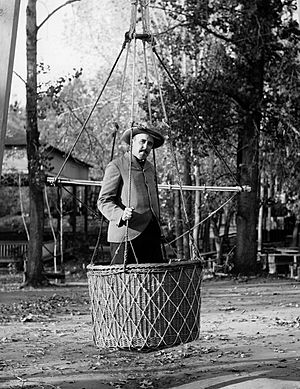Harry Buckwalter facts for kids
Quick facts for kids
Harry Buckwalter
|
|
|---|---|
 |
|
| Born |
Harry Hale Buckwalter
November 1, 1867 |
| Died | March 7, 1930 (aged 62) |
| Nationality | American |
| Occupation |
|
| Spouse(s) | Carrie Emmajean Fuller |
Harry Hale Buckwalter (born November 1, 1867 – died March 7, 1930) was an American photographer, journalist, and a pioneer in early films. He was also known as a photojournalist, which means he told stories with pictures in newspapers. Harry Buckwalter also directed and produced silent films.
Contents
Harry Buckwalter's Life Story
Harry Hale Buckwalter was born in Reading, Pennsylvania. When he was 16, he moved to the American West. In Colorado Springs, he met Carrie Emmajean Fuller. They got married in 1889. Later, they moved to Denver and had two children, John and Margaret.
Starting a Career in Photography
In 1892, Harry became very interested in photography. He started working at The Denver Republican newspaper. Then, he moved to the Rocky Mountain News in Denver. This was the first daily newspaper in Colorado. At first, artists would draw his photos using wood blocks. Later, printing technology improved. This allowed his photos to be printed directly using a method called halftone.
Taking Pictures from the Sky
In 1894, Buckwalter worked with a balloonist named Ivy Baldwin. They planned to take pictures of Colorado from a hot air balloon. Baldwin's balloon was not strong enough for both of them. So, Harry went up alone from Elitch Gardens in Denver. He wrote an article called "Dancing in the Air." His photos and story were some of the first examples of photojournalism in the American West.
Discovering X-ray Photography
In 1895, Harry Buckwalter became interested in X-ray technology. This was soon after Professor Wilhelm Röntgen discovered it. The Rocky Mountain News newspaper supported Harry's work. He teamed up with Dr. C. E. Tennant and the Homeopathic Medical College of Denver. They did many experiments with X-ray photography.
Harry made his own X-ray tubes using leaded glass. People thought this type of glass would not work. But Harry's experiments showed that leaded tubes could create clear X-ray images. These were the first X-ray images made in the American West. They were also among the very first in the entire country.
X-rays in Court
After the Rocky Mountain News published their findings, lawyers contacted Buckwalter and Tennant. They wanted to use the new X-ray technology in a court case. The case was about James Smith, who had broken his leg. A doctor had wrongly said his leg was just stiff. The doctor told him to exercise, which made the injury worse.
The court case happened on December 2, 1896. The judge allowed Buckwalter and Tennant to share their findings. They showed the X-rays as evidence. The other side argued that X-rays were "the testimony of a ghost." But the X-rays and their explanations proved there was a broken bone. This was a very important moment. It was the first time X-ray evidence was allowed in a court of law.
Making Early Films
Harry Buckwalter started making films called travelogues. These films showed scenes of the American West for railway companies. He also worked on improving high-speed camera shutters. Many of his early films were shown in "Hale's Tours of the World." This was an early amusement ride where people sat in a fake train car.
In 1900, Harry began working with filmmaker William Selig. Harry became the Western agent for Selig's company. He sold and gave out Selig's projectors and films to theaters.
Founding Buckwalter Films
By 1902, Harry Buckwalter started his own studio called Buckwalter Films. He began directing and producing short silent films. One of his first was The Girls in the Overalls. This film was about seven sisters who ran a ranch after their parents died. It was one of the earliest western films made in America.
In 1903, the Royal Photographic Society gave top awards to his films Panorama of the Royal Gorge and Panorama of Ute Pass. Several of Harry's documentary films were also shown at the 1904 St. Louis World's Fair.
In 1905, Harry Buckwalter was asked to film President Theodore Roosevelt's hunting trip in western Colorado.
In 1910, Buckwalter Films joined the General Film Company. Harry's last known film was a documentary about building the Panama Canal. He filmed it in 1913.
Today, the History Colorado Center and the Denver Public Library have many of Harry Buckwalter's photos and glass plate negatives. Sadly, many of his films are now lost.
Harry Buckwalter passed away on March 7, 1930, when he was 63 years old.


